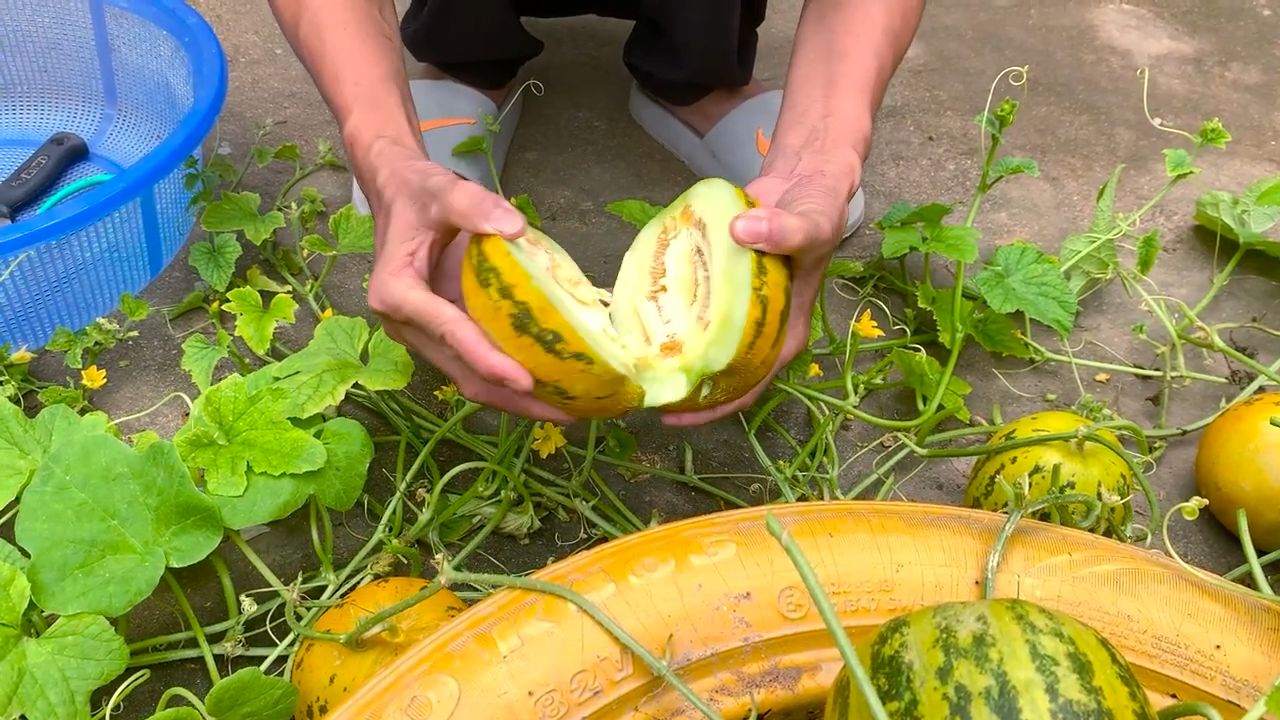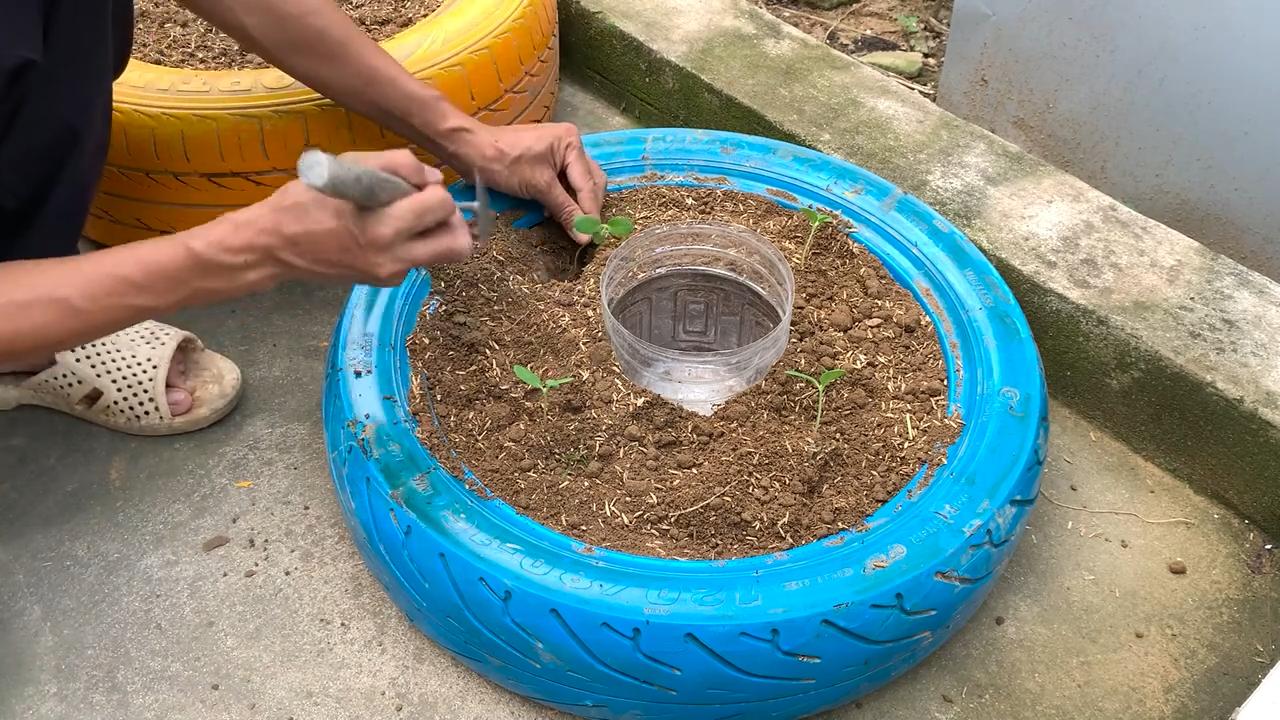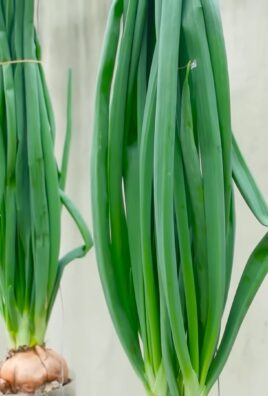Easy Melon Growing Tips are what every gardener craves when summer rolls around, right? I know I do! Imagine biting into a juicy, homegrown melon, bursting with flavor that store-bought ones just can’t match. That’s the dream, and it’s more achievable than you might think, even if you’re a beginner gardener.
Melons have a rich history, dating back thousands of years to Africa and Asia. They were prized by ancient civilizations for their sweetness and hydrating properties. Think of Cleopatra enjoying a refreshing slice – that could be you! But let’s be honest, growing these delicious fruits can sometimes feel like a challenge. That’s where these DIY tricks and hacks come in.
Let’s face it, nobody wants to spend time and effort only to end up with small, bland melons. That’s why I’ve compiled these easy melon growing tips to help you maximize your yield and enjoy the sweetest, most flavorful melons you’ve ever tasted. From soil preparation to pest control, these simple DIY solutions will empower you to create a thriving melon patch, no matter the size of your garden. So, grab your gardening gloves, and let’s get started on the path to melon-growing success!

Grow Your Own Delicious Melons: A Beginner’s Guide
Hey there, fellow gardening enthusiasts! I’m so excited to share my tried-and-true methods for growing juicy, flavorful melons right in your own backyard. Forget those bland, store-bought melons – with a little know-how, you can enjoy the sweet taste of homegrown goodness all summer long. This guide is designed for beginners, so don’t worry if you’ve never grown melons before. I’ll walk you through every step, from choosing the right variety to harvesting your prize-winning fruit.
Choosing the Right Melon Variety
Before you even think about planting, it’s crucial to select a melon variety that suits your climate and growing conditions. Here’s a quick rundown of some popular choices:
* Watermelons: These summer staples thrive in warm climates with long growing seasons. Consider varieties like ‘Sugar Baby’ (early maturing and compact), “Crimson Sweet” (classic flavor and large size), or ‘Yellow Doll’ (unique yellow flesh).
* Cantaloupes: These fragrant melons are relatively easy to grow and prefer warm, sunny locations. ‘Athena’ and ‘Hales Best Jumbo’ are reliable choices.
* Honeydew Melons: Similar to cantaloupes in their growing requirements, honeydews offer a smooth, pale green flesh and a subtly sweet flavor. ‘Honeycrisp’ is a popular variety.
* Specialty Melons: If you’re feeling adventurous, try growing unique varieties like Galia melons (sweet and aromatic) or Crenshaw melons (large and flavorful).
Important Considerations:
* Climate: Make sure the variety you choose is suitable for your region’s climate and growing season length.
* Space: Melons need plenty of space to sprawl, so consider the size of your garden. Bush varieties are available for smaller gardens.
* Disease Resistance: Look for varieties that are resistant to common melon diseases like powdery mildew and fusarium wilt.
Preparing Your Melon Patch
Melons are heavy feeders, meaning they need nutrient-rich soil to thrive. Proper soil preparation is key to a successful harvest.
* Sunlight: Melons need at least 6-8 hours of direct sunlight per day. Choose a location that receives plenty of sun.
* Soil: Melons prefer well-drained, sandy loam soil with a pH between 6.0 and 6.8.
* Amendments: Amend your soil with plenty of organic matter, such as compost, aged manure, or leaf mold. This will improve drainage, fertility, and water retention.
Planting Your Melon Seeds or Transplants
You can start melon seeds indoors 4-6 weeks before the last expected frost, or you can direct sow them in the garden after the soil has warmed up to at least 70°F (21°C).
Starting Seeds Indoors:
1. Sow Seeds: Fill seed trays or small pots with seed-starting mix. Sow seeds about 1 inch deep.
2. Water Gently: Water the soil gently to moisten it, but avoid overwatering.
3. Provide Warmth: Place the trays or pots in a warm location, such as on a heat mat or near a sunny window.
4. Keep Moist: Keep the soil consistently moist, but not soggy.
5. Harden Off: Once the seedlings have developed a few sets of true leaves, gradually acclimate them to outdoor conditions by hardening them off for a week before transplanting.
Direct Sowing Seeds:
1. Prepare Soil: Prepare the soil as described above.
2. Create Mounds: Create small mounds of soil about 2-3 feet apart.
3. Sow Seeds: Sow 3-4 seeds per mound, about 1 inch deep.
4. Water Gently: Water the soil gently to moisten it.
5. Thin Seedlings: Once the seedlings emerge, thin them to the strongest one per mound.
Transplanting Seedlings:
1. Dig Holes: Dig holes in the prepared soil, spacing them according to the variety’s recommendations (usually 2-3 feet apart).
2. Remove Seedlings: Gently remove the seedlings from their containers, being careful not to damage the roots.
3. Plant Seedlings: Place the seedlings in the holes and backfill with soil.
4. Water Thoroughly: Water the seedlings thoroughly after planting.
Caring for Your Melon Plants
Once your melon plants are established, it’s important to provide them with proper care to ensure a bountiful harvest.
* Watering: Melons need consistent watering, especially during hot, dry weather. Water deeply and regularly, aiming for about 1-2 inches of water per week. Avoid overhead watering, as this can promote fungal diseases. Drip irrigation is an excellent option.
* Fertilizing: Feed your melon plants with a balanced fertilizer every 2-3 weeks. Look for a fertilizer that is high in phosphorus and potassium, which are essential for fruit development.
* Weeding: Keep your melon patch free of weeds, which can compete with the plants for nutrients and water. Mulching can help suppress weeds and retain moisture.
* Pruning: While not always necessary, pruning can help improve air circulation and fruit production. Remove any dead or diseased leaves and stems. You can also pinch off the tips of the vines to encourage branching.
* Pollination: Melons rely on bees and other pollinators to produce fruit. If you notice a lack of bee activity, you can hand-pollinate the flowers by transferring pollen from the male flowers to the female flowers using a small brush. Female flowers have a small swelling at the base (the future melon).
* Pest and Disease Control: Monitor your melon plants regularly for pests and diseases. Common pests include aphids, squash bugs, and cucumber beetles. Common diseases include powdery mildew and fusarium wilt. Use organic pest control methods whenever possible, such as insecticidal soap or neem oil. Choose disease-resistant varieties to minimize the risk of disease.
Protecting Your Melons
As your melons start to ripen, they become vulnerable to pests and diseases. Here are some tips for protecting your precious fruit:
* Elevate Melons: Place melons on straw, cardboard, or wooden boards to prevent them from rotting on the ground.
* Protect from Pests: Use netting or row covers to protect melons from pests like birds, squirrels, and insects.
* Monitor for Diseases: Keep an eye out for signs of disease, such as spots on the leaves or fruit. Remove any infected leaves or fruit immediately.
Harvesting Your Melons
Knowing when to harvest your melons is crucial for enjoying their peak flavor and sweetness. Here are some general guidelines:
* Watermelons: Look for a dull, thumping sound when you tap the melon. The tendril closest to the melon should be brown and dry. The underside of the melon (where it rests on the ground) should be yellow or cream-colored.
* Cantaloupes: The melon should slip easily from the vine with a gentle tug. The skin should be a golden-tan color and have a fragrant aroma.
* Honeydew Melons: The skin should be a creamy white color and have a slightly waxy feel. The blossom end should be slightly soft.
Harvesting Tips:
* Use a sharp knife or pruning shears to cut the melon from the vine.
* Handle melons carefully to avoid bruising.
* Store melons in a cool, dry place.
Troubleshooting Common Melon Problems
Even with the best care, you may encounter some problems while growing melons. Here are some common issues and how to address them:
* Poor Fruit Set: This can be caused by a lack of pollination, cool temperatures, or nutrient deficiencies. Hand-pollinate the flowers, provide adequate warmth, and fertilize regularly.
* Cracked Fruit: This can be caused by inconsistent watering or rapid changes in temperature. Water regularly and consistently, and protect melons from extreme temperature fluctuations.
* Blossom End Rot: This is caused by a calcium deficiency. Amend your soil with calcium-rich amendments, such as bone meal or crushed eggshells.
* Pest Infestations: Use organic pest control methods to control pests.
* Disease Problems: Choose disease-resistant varieties and practice good sanitation to prevent disease.
Enjoying Your Homegrown Melons
Congratulations! You’ve successfully grown your own delicious melons. Now it’s time to enjoy the fruits (literally!) of your labor.
* Eat Fresh: Slice and enjoy your melons fresh from the garden.
* Make Smoothies: Blend melons into refreshing smoothies.
* Add to Salads: Dice melons and add them to salads for a sweet and juicy twist.
* Grill Melons: Grill melon slices for a smoky

Conclusion
So, there you have it! Mastering these easy melon growing tips isn’t just about cultivating delicious fruit; it’s about unlocking a rewarding gardening experience. From selecting the perfect sunny spot to nurturing your seedlings and providing the right support, each step contributes to a bountiful harvest of sweet, juicy melons.
Why is this DIY approach a must-try? Because it empowers you to take control of your food source, ensuring you know exactly what goes into your melons, from the soil they grow in to the water they receive. Store-bought melons, while convenient, often lack the intense flavor and satisfying sweetness of homegrown varieties. Plus, there’s an undeniable sense of accomplishment that comes with nurturing a plant from seed to table.
But the benefits extend beyond just taste and satisfaction. Growing your own melons is a sustainable practice, reducing your reliance on commercially produced food and minimizing your carbon footprint. It’s also a fantastic way to connect with nature, relieve stress, and get some much-needed fresh air and sunshine.
Ready to take your melon growing to the next level? Consider these variations and suggestions:
* Vertical Gardening: If space is limited, explore vertical gardening techniques. Train your melon vines to climb a trellis or fence, maximizing your yield in a small area. This also improves air circulation, reducing the risk of fungal diseases.
* Companion Planting: Plant beneficial companions alongside your melons. Marigolds deter pests, while basil enhances flavor. Research other companion plants that can improve soil health and attract pollinators.
* Grafting: For advanced gardeners, grafting melon scions onto more vigorous rootstocks can improve disease resistance and increase yields. This technique requires some skill and practice, but the results can be impressive.
* Different Melon Varieties: Don’t limit yourself to just one type of melon! Experiment with different varieties, such as cantaloupe, honeydew, watermelon, and specialty melons like Galia or Charentais. Each variety offers a unique flavor profile and texture.
* Seed Saving: Save seeds from your best-performing melon plants to perpetuate desirable traits in future generations. This is a great way to adapt your melons to your specific growing conditions.
We encourage you to embrace these easy melon growing tips and embark on your own melon-growing adventure. Don’t be afraid to experiment, learn from your mistakes, and adapt your techniques to suit your local climate and soil conditions.
Most importantly, share your experiences with us! We’d love to hear about your successes, challenges, and favorite melon varieties. Post photos of your melon harvests on social media using #HomegrownMelons and tag us so we can celebrate your achievements. Let’s build a community of passionate melon growers and inspire others to discover the joys of homegrown produce. Happy gardening!
Frequently Asked Questions (FAQ)
What is the best time to start melon seeds indoors?
The ideal time to start melon seeds indoors is typically 4-6 weeks before the last expected frost in your area. This allows the seedlings to develop a strong root system before being transplanted outdoors. Check your local frost dates to determine the appropriate timing for your region. Starting too early can result in leggy, weak seedlings, while starting too late may delay your harvest.
How much sunlight do melons need?
Melons are sun-loving plants and require at least 6-8 hours of direct sunlight per day to thrive. Choose a planting location that receives full sun throughout the day. Insufficient sunlight can lead to poor fruit development, reduced sweetness, and increased susceptibility to diseases. If you live in a particularly hot climate, providing some afternoon shade can help prevent sunburn on the fruits.
What type of soil is best for growing melons?
Melons prefer well-drained, fertile soil that is rich in organic matter. Amend your soil with compost or well-rotted manure before planting to improve drainage, fertility, and water retention. A slightly acidic to neutral soil pH (6.0-7.0) is ideal. Avoid heavy clay soils, as they can become waterlogged and inhibit root growth.
How often should I water my melon plants?
Water melon plants deeply and regularly, especially during hot, dry weather. Aim to keep the soil consistently moist but not waterlogged. Water at the base of the plants to avoid wetting the foliage, which can increase the risk of fungal diseases. As the fruits begin to ripen, reduce watering slightly to concentrate the sugars and enhance flavor.
What are some common pests and diseases that affect melons?
Common pests that affect melons include aphids, squash bugs, cucumber beetles, and vine borers. Diseases include powdery mildew, downy mildew, and fusarium wilt. Monitor your plants regularly for signs of pests or diseases and take appropriate action, such as using insecticidal soap, neem oil, or fungicide. Crop rotation and good sanitation practices can also help prevent pest and disease problems.
How do I know when my melons are ripe?
The signs of ripeness vary depending on the type of melon. For cantaloupe, look for a sweet aroma, a slight softening at the blossom end, and a stem that slips easily from the vine. For watermelon, check for a dull thud when you tap the fruit, a yellow spot on the underside where it rested on the ground, and a dried tendril near the stem. Honeydew melons are ripe when they turn a creamy yellow color and have a slightly waxy feel.
Can I grow melons in containers?
Yes, you can grow melons in containers, but you’ll need to choose a large container (at least 20 gallons) and select a compact or bush variety. Provide adequate support for the vines and ensure the container has good drainage. Container-grown melons may require more frequent watering and fertilization than those grown in the ground.
How can I improve pollination of my melon plants?
Melons rely on pollinators, such as bees, to set fruit. Attract pollinators to your garden by planting flowering herbs and vegetables nearby. If you’re not seeing enough pollinator activity, you can hand-pollinate your melon flowers by transferring pollen from the male flowers to the female flowers using a small brush.
What is the best way to store harvested melons?
Store ripe melons in the refrigerator to slow down ripening and prevent spoilage. Whole melons can be stored for up to a week, while cut melons should be stored in an airtight container and consumed within a few days.
Are there any specific fertilizer requirements for melons?
Melons benefit from regular fertilization throughout the growing season. Use a balanced fertilizer with a higher phosphorus content to promote fruit development. Avoid over-fertilizing with nitrogen, as this can lead to excessive foliage growth at the expense of fruit production. Follow the instructions on the fertilizer label carefully.




Leave a Comment